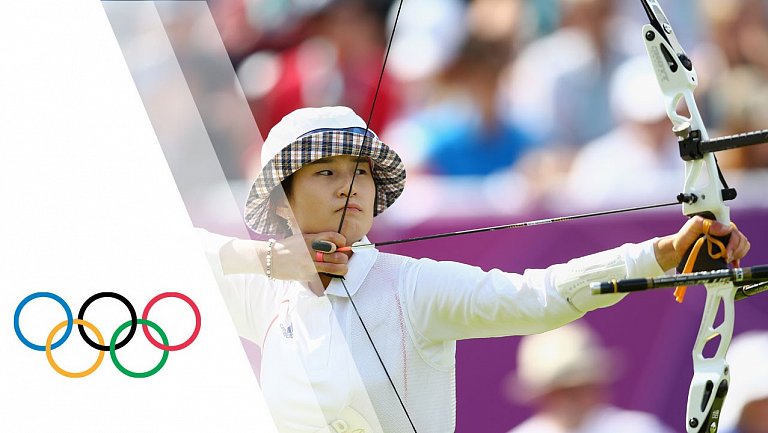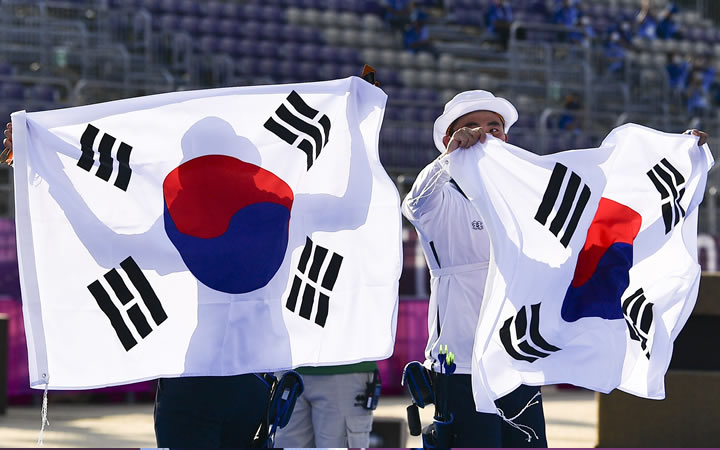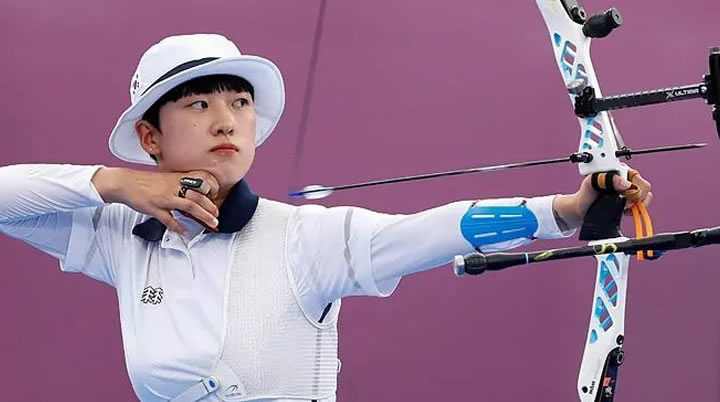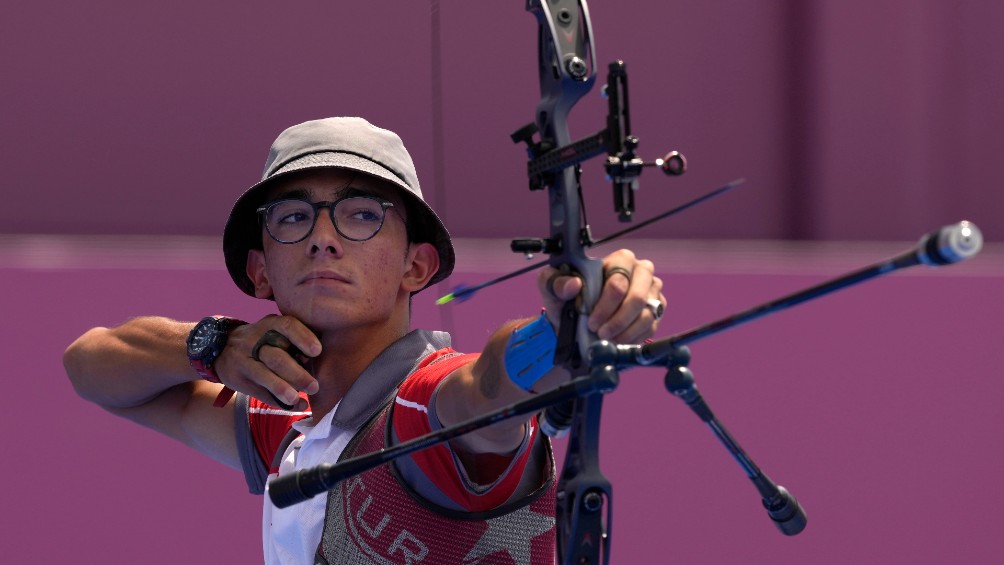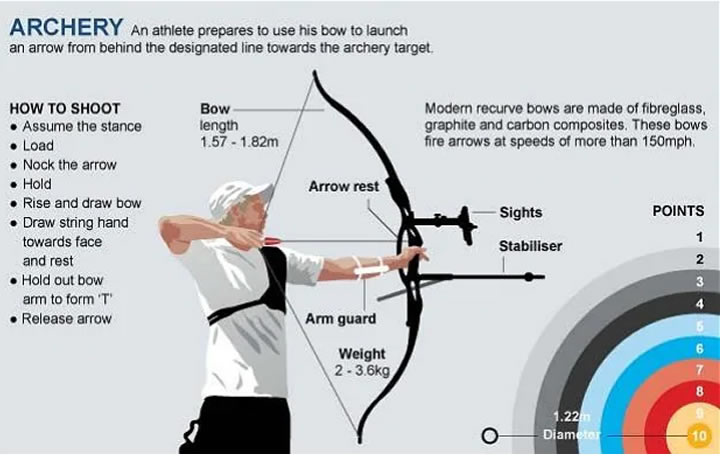Archery is one of the fastest-growing sports in which athletes compete for the accuracy and precision of archery ability. The athlete who gets the maximum number of points according to the rules of the tournament wins the competition. Archery is part of the Summer Olympics program.
Archer athletes participated in the Olympic competitions at the 1900 Paris Olympic Games and continued to the 1920 Summer Olympics in Antwerp. The only exception was in the 1912 Summer Olympics in Stockholm.
Later, in 1920 archery was dropped from the list of Olympic disciplines.
In 1972, archery competitions were returned to the Summer Olympics program.
By the way, archery is the only Olympic sport discipline in which people with disabilities have the same rights and opportunities and can participate in the overall standings.
The goal of archery is to hit the very smallest inner ring of the target with the arrow. The target itself is 1.22 m in circumference. The Olimpic distance is 70 m, and the arrow’s average speed is about 240 km per hour.
- For hitting the center ring, 10 points are awarded.
- For hitting each of the following ten rings from the center, the number of points is reduced by 1.
- If the arrow hits the line of the boundaries between the rings, then the higher value is counted.
- At the very center of the target, there is another ring called the X10, which is used to determine the proximity of the arrow to the center.
- Hitting X10 adds 10 points.
- If both athletes are in the same scoring zone, the winner is the one whose arrow is closer to the X10 zone.
The winner is the athlete or team with the most points by the competition rules.
Archery results at the Tokyo Olympics
Archers qualify for the Olympic Games based on the results of the regular season. At the selection stage, each athlete is given 72 shots. According to the results of the qualification, the 64 best single archers and 16 teams are determined.
In the individual category, athletes start from the 1/32 finals, and in the team category – from the quarterfinals.
The archery competition at the 2020 Summer Olympics in Tokyo was held at Yumenoshima Park from July 23rd to 31st. Five events were planned, with a mixed-team event being held for the first time.
- On the first day of the Olympics, qualifying rounds were held in individual competitions for men and women.
- On the second day, medals were played (the first in history) in the team mixed competition.
- The program of competitions ended with individual competitions for men and women.
Mixed team event: In the mixed team event, the top 16 teams will compete in a single-elimination tournament bracket. As with the men’s and women’s team events, two arrows per team member are allowed. This means four arrows per team in a mixed-team tournament with a total of four sets.
Men’s and women’s team events: In the team events, compete in the top 4 teams. The team event follows the same archery Olympic round set system as the individual event, though each set consists of six arrows (two per team member), and only four sets are held.
Individual competitions: In the individual events, all competitors are expected to enter the competition. Each match is to be scored using the Archery Olympic Round, consisting of the best-of-five sets, with three arrows per set.
The winner of each set receives two points, and if the scores in the set are tied then each archer receives one point. If the score is tied at 5–5 at the end of five sets, a single arrow shoot-off is held and the closest to the center is declared the winner.
July 24: Mixed team
- South Korea (Kim Je-deok, An San)
- Netherlands (Steve Wijler, Gabriela Schloesser)
- Mexico (Luis Álvarez, Alejandra Valencia)
July 25: Women’s teams (medalists):
- South Korea (An San, Jang Min-hee, Kang Chae-young)
- ROC (Svetlana Gomboeva, Elena Osipova, Ksenia Perova)
- Germany (Michelle Kroppen, Charline Schwarz, Lisa Unruh)
July 26: Men’s teams (medalists):
- South Korea (Kim Woo-jin, Oh Jin-hyek, Kim Je-deok)
- Chinese Taipei (Deng Yu-cheng, Tang Chih-chun, Wei Chun-heng)
- Japan (Takaharu Furukawa, Yuki Kawata, Hiroki Muto)
July 30: Women’s individuals (medalists):
- An San (South Korea)
- Elena Osipova (ROC)
- Lucilla Boari (Italy)
July 31: Men’s individuals (medalists):
- Mete Gazoz (Turkey)
- Mauro Nespoli (Italy)
- Takaharu Furukawa (Japan)
The archery equipment
The Olympic bow is made of fiberglass and weighs on average 2 to 3 kg. There are two types of professional bows used in official archery competitions:
- Traditional classic recurve bow: This bow is used in the Olympic Games. The pulling force is about 15-20 kg. The arrow’s flight speed reaches 240 km per hour.
- Compound bow: In this type of bow, a special mechanism provides the arrow with a more correct acceleration and facilitates the process of drawing the bow. The pulling force of this bow is about 25-30 kg. The arrow’s flight speed reaches 320 km per hour.
Modern archery sports arrows are composite (tip, shaft, shank, plumage) and made of aluminum and carbon fiber. Arrows are stacked into a special arrow quiver.
A quiver is a container for arrows. Quivers are usually worn on the body of an archer, on a bow, or the ground, depending on the type of shooting and personal preference of the athlete.
The release is a trigger with which the archer grabs the bowstring and then releases it at the right moment, launching an arrow. This reduces the deformation of the arrow and thus increases the shooting stability.






